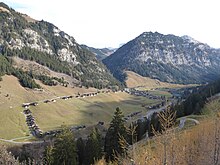Beigla
Beigla are mainly found in the western Alpine region, on which portions of forest and grazing rights are notched in peasant alpine cooperatives. Such wooden legal documents were in use in Liechtenstein, Graubünden and Valais until the middle of the 19th century; from then on they were gradually replaced by written documents. The name Beigla is probably derived from the Alemannic Beiala = incision .
The best preserved, almost complete bundle of such Beigla documents the distribution of shares in the Triesenberger Maiensässen Gross- and Chleistäg as well as Silum . The bundle comprises 59 pieces of wood of different sizes, in which the respective proportions are notched: A continuous notch means a portion of pasture, half a notch corresponds to half a portion and a point means a quarter of a portion of pasture. A total of 208 and a quarter of pasture shares were awarded in this way. In addition to the notches that mark the grazing rights, the woods usually have notched house signs that identify the respective owner. Some of these woods are very artistically made, others just simple everyday objects. On some of them there is no corresponding house sign and the name of the owner was noted on the stick with Indian ink or writing ink. Changes of ownership were only allowed to be carved in the presence of the pastor, judge (community leader), church caretaker and probably also juries and Alpine bailiffs. In 1868 a willow book was created and the Beigla were no longer needed.
literature
- David Beck (archaeologist) : The Alprechtshölzer or Beigla of the Alpgenossenschaft Grosssteg in the municipality of Triesenberg. In: Yearbook of the Historical Association for the Principality of Liechtenstein (1942) (42) pp. 57–73
- Josef Eberle: Beigla. In: Historical Lexicon of the Principality of Liechtenstein . December 31, 2011 , accessed July 9, 2019 .

